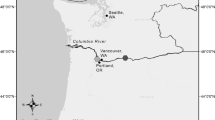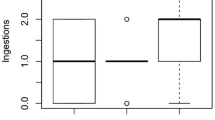Abstract
The copepod Boeckella poppei is a major species in high latitude lakes of the Southern Hemisphere. In such lakes the reduced diversity of metazoans contrasts with a rich microbial assemblage, making these systems amenable to the study of predation controls on the microbial food web. However, the diet of B. poppei is subject to conflicting reports, with little information on feeding rates. We incubated this species in water from Sombre Lake, a much-studied maritime Antarctic Lake on the South Orkney Islands, in order to quantify its feeding rates and potential impact on the microbial assemblage. Overall, clearance rates were similar across 4 experiments spanning November 1999–March 2000, but increased with prey size over the range of 2.7–18 μm equivalent spherical diameter (esd). B. poppei fed omnivorously, although small phototrophic flagellates comprised the bulk of the diet because of their overwhelming dominance in the incubation water. Larger motile preys—heterotrophic ciliates of ~18 μm esd—were cleared fastest (mean 555 ml mg−1 dry mass day−1) and at equivalent rates to those found for freshwater and marine copepods of similar size and at similar temperatures. Estimated predation impact on the microbial food web varied with the abundance of copepods; these were ~30-fold greater in March than in December. In March even the relatively abundant B. poppei (1.7 adults l−1) had a negligible impact on nanoflagellates, due to the low clearance rate on these small cells. However, in March, B. poppei adults were estimated to clear 24% of the lake water of ciliates daily. Given the generation time of ciliates (1.6 days measured in a previous summer study), and the fact that other larval stages of B. poppei were not assessed, this species has the potential to control this part of the microbial assemblage in Sombre Lake.


Similar content being viewed by others
References
Almada P, Allende L, Tell G, Izaguirre I (2004) Experimental evidence of the grazing impact of Boeckella poppei on phytoplankton in a maritime Antarctic lake. Polar Biol 28:39–46
Atkinson A. (1995) Omnivory and feeding selectivity in five copepod species during spring in the Bellingshausen Sea, Antarctica. ICES J Mar Sci 52:385–396
Båmstedt U, Gifford DJ, Irigoien X, Atkinson A, Roman M (2000) Feeding. In: Harris RP, Wiebe PH, Lenz J, Skjoldal HR, Huntley M (eds) ICES zooplankton methodology manual. Academic, London, pp 297–399
Balseiro EG, Modenutti BE, Queimaliňos CP (2001) feeding of Boeckella gracilipes (Copepoda, Calanoida) on ciliates and phytoflagellates in an ultraoligotrophic Andean Lake. J Plankton Res 23:849–857
Bayly IAE (1992) Fusion of the genera Boeckella and Pseudoboeckella (Copepoda) and revision of their species from South America and sub-Antarctic islands. Revista Chilena de Historia Natural 65:17–63
Berggreen U, Hansen B, Kiørboe T (1988) Food size spectra, ingestion and growth of the copepod Acartia tonsa during development: implications for the determination of copepod production. Mar Biol 99:341–352
Burns CW, Gilbert JJ (1993) Predation on ciliates by freshwater calanoid copepods: rates of predation and relative vulnerabilities of prey. Freshw Biol 30:377–393
Burns CW, Schallenberg M (1998) Impacts of nutrients and zooplankton on the microbial food web of an ultra-oligotrophic lake. J Plankton Res 20:1501–1525
Butler HG (1999) Temporal plankton dynamics in a maritime Antarctic lake. Arch Hydrobiol 146:311–339
Carrick HJ, Fahnenstiel GL, Stoermer EF, Wetzel RG (1991) The importance of zooplankton-protozoan trophic couplings in Lake Michigan. Limnol Oceanogr 36:1335–1345
Clarke AJ, Ellis-Evans JC, Sanders MW, Holmes LJ (1989) Patterns of energy storage in Pseudoboeckella poppei (Crustacea, Copepoda) from two contrasting lakes on Signy Island, Antarctica. Hydrobiologia 172:183–191
DeMott WR, Watson MD (1991) Remote detection of algae by copepods: responses to algal size, odors and motility. J Plankton Res 13:1203–1222
Ellis-Evans JC (1991) Numbers and activity of bacterio- and phytoplankton in contrasting maritime Antarctic lakes. Verh Int Verein Limnol 24:1149–1154
Ellis-Evans JC (1996) Microbial diversity and function in Antarctic freshwater ecosystems. Biodivers Conserv 5:1395–1431
Gauld DT (1951) The grazing rate of planktonic copepods. J Mar Biol Assoc UK 29:695–706
Gifford DJ (1993) Protozoa in the diets of Neocalanus spp. in the oceanic subarctic Pacific Ocean. Prog Oceanogr 32:223–237
Hansson L-A, Tranvik LJ (1996) Quantification of invertebrate predation and herbivory in food chains of low complexity. Oecologia 108:542–551
Hansson L-A, Tranvik JJ (2003) Food webs in sub-Antarctic lakes: a stable isotope approach. Polar Biol 26:783–788
Hawes I (1983) Nutrients and their effects on phytoplankton in lakes on Signy Island, Antarctica. Polar Biol 2:115–126
Hawes I (1985) Factors controlling phytoplankton populations in maritime Antarctic lakes. In Siegfried WR, Condy PR, Laws RM (eds) Antarctic nutrient cycles and food webs. Springer, Berlin Heidelberg New York, pp 245–252
Heywood RB (1970a) The mouthparts and feeding habits of Parabroteas sarsi (Daday) and Pseudoboeckella silvestri, Daday (Copepoda, Calanoida). In: Holdgate MW (ed) Antarctic ecology. Academic, London, pp 639–650
Heywood RB (1970b) Ecology of the fresh-water lakes of Signy Island, South Orkney Islands: III. Biology of the copepod Pseudoboeckella silvestri Daday (Calanoida, Centropagidae). Br Antarct Surv Bull 23:1–17
Heywood RB (1977) The correct identity of a Pseudoboeckella sp. (Copepoda, Calanoida) from Signy Island, South Orkney Islands. Br Antarct Surv Bull 45:147–149
Hodgson DA, Johnston NM, Caulkett AP, Jones VI (1998) Paleolimnology of Antarctic fur seal Arctocephalus gazella populations and implications for Antarctic management. Biol Conserv 83:145–154
Izaguirre I, Allende L, Marinone MC (2003) Comparative study of the planktonic communities of three lakes of contrasting trophic status at Hope Bay (Antarctic Peninsula). J Plankton Res 25:1079–1097
Kiørboe T, Saiz E, Viitasalo M (1996) Prey switching behaviour in the planktonic copepod Acartia tonsa. Mar Ecol Prog Ser 143:65–75
Kleppel GS (1993) On the diets of calanoid copepods. Mar Ecol Prog Ser 99:183–195
Laybourn-Parry J, Ellis-Evans JC, Butler H (1996) Microbial dynamics during the summer ice-loss phase in maritime Antarctic lakes. J Plankton Res 18:495–511
Mackereth FJH, Heron J, Talling JF (1989) Water Analysis: Some Revised Methods for Limnologists. Freshwater Biological Association, Ambleside
Ohman MD, Runge JA (1996) Sustained fecundity when phytoplankton resources are in short supply: omnivory by Calanus finmarchicus in the Gulf of St Lawrence. Limnol Oceanogr 39:21–36
Rothhaupt KO (1991) The influence of toxic and filamentous blue-green algae on feeding and population growth of the rotifer Branchionus rubens. Int Rev Ges Hydrobiol 76:67–72
Schmidt K, Jónasdóttir S (1997) Nutritional quality of two cyanobacteria: How rich is ‘poor’ food? Mar Ecol Prog Ser 151:1–10
Schnack SB (1985) Feeding by Euphausia superba and copepod species in response to varying concentrations of phytoplankton. In: Siegfried WR, Condy PR, Laws RM (eds) Antarctic nutrient cycles and food webs. Springer, Berlin Heidelberg New York, pp 311–323
Smith RIL (1987) Impact of an increasing fur seal population on Antarctic plant communities: resilience and recovery. In: Battaglia B, Valencia J, Walton DWH (eds) Antarctic Communities: Species, Structure and Survival. Cambridge University Press, Cambridge, pp 4342–436
Stoecker DK, Capuzzo JM (1990) Predation on Protozoa: its importance to zooplankton. J Plankton Res 12:891–908
Stoecker DK, Gifford DJ, Putt M (1994) Preservation of marine planktonic ciliates: losses and cell shrinkage during fixation. Mar Ecol Prog Ser 110:293–299
Swadling KM, Gibson JAE (2000) Grazing rates of a calanoid copepod (Paralabidocera antarctica) in a continental Antarctic lake. Polar Biol 23:301–308
Utermöhl H (1958): Zur vervollkommnung der quantitativen phytoplankton methodik Mitt. Int Ver Theor Angew Limnol 9:1–38
Weller DLM (1977) Observations on the diet and development of Pseudoboeckella poppei (Calanoida, Centropagidae) from an Antarctic lake. Br Antarct Surv Bull 45:77–92
Welschmeyer NA (1994) Fluorometric analysis of chlorophyll-a in the presence of chlorophyll-b and phaeopigments. Limnol Oceanogr 39:1985–1992
Acknowledgements
We thank M. Edworthy for providing the physical and chemical data and all those working at Signy Base in the 1999–2000 austral summer for their support.
Author information
Authors and Affiliations
Corresponding author
Rights and permissions
About this article
Cite this article
Butler, H., Atkinson, A. & Gordon, M. Omnivory and predation impact of the calanoid copepod Boeckella poppei in a maritime Antarctic lake. Polar Biol 28, 815–821 (2005). https://doi.org/10.1007/s00300-005-0014-4
Received:
Revised:
Accepted:
Published:
Issue Date:
DOI: https://doi.org/10.1007/s00300-005-0014-4




